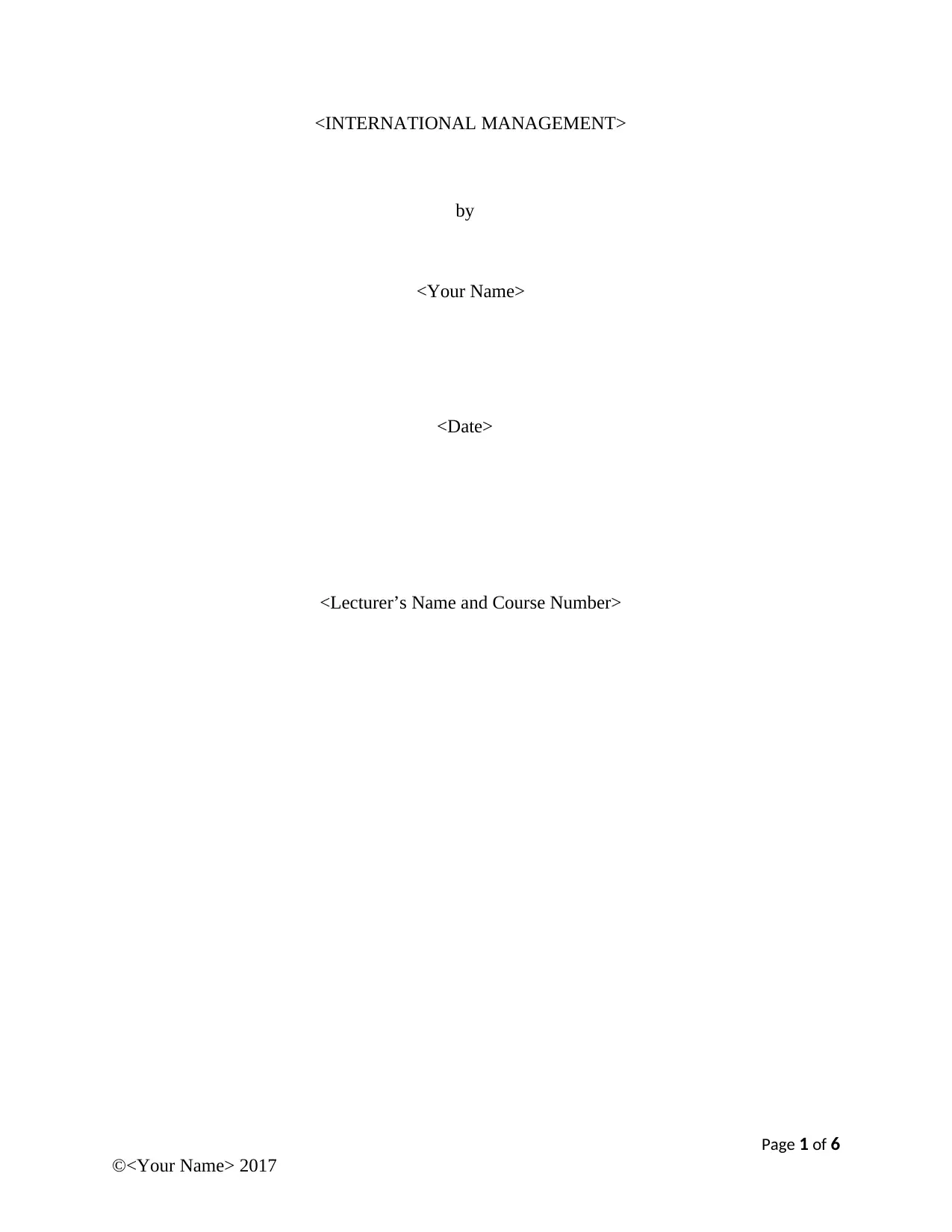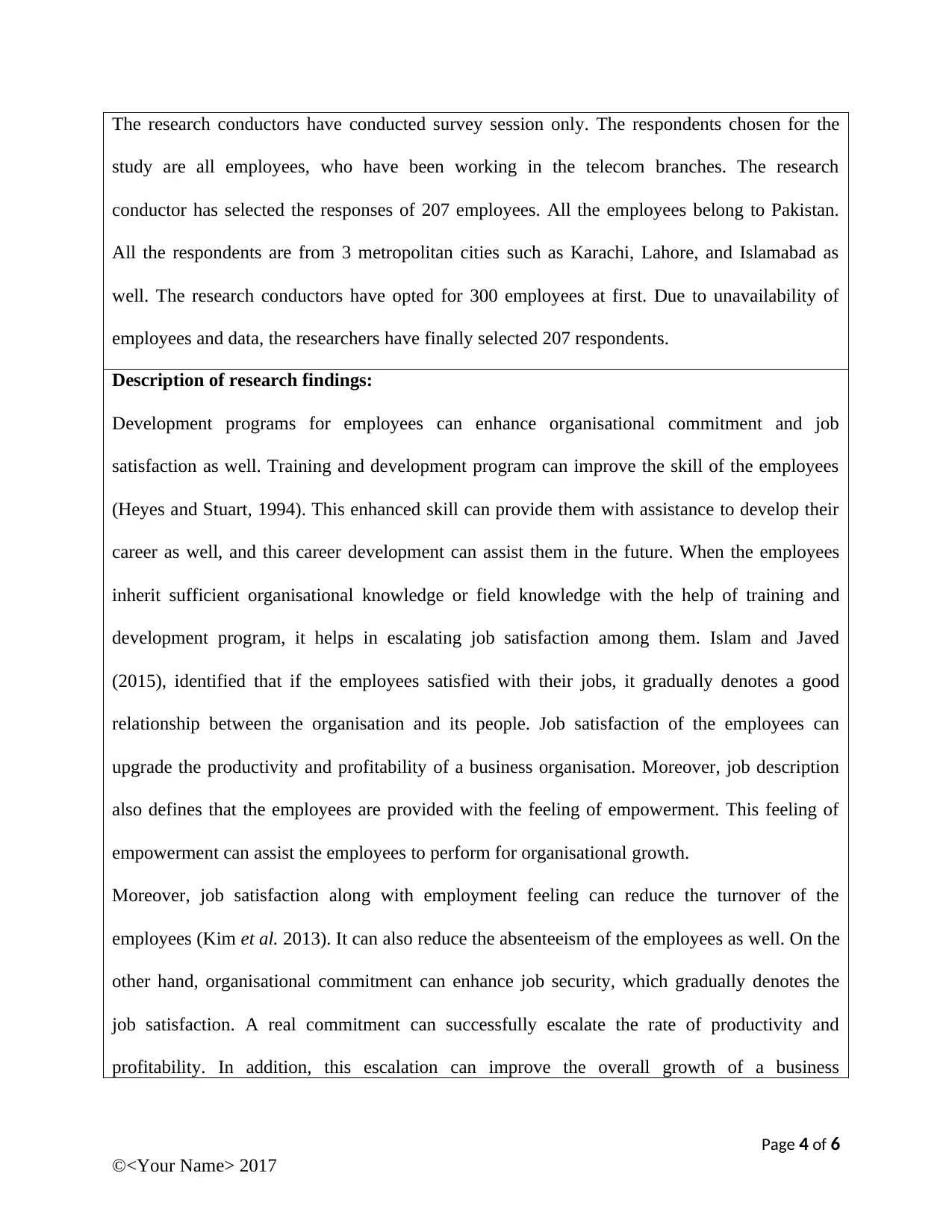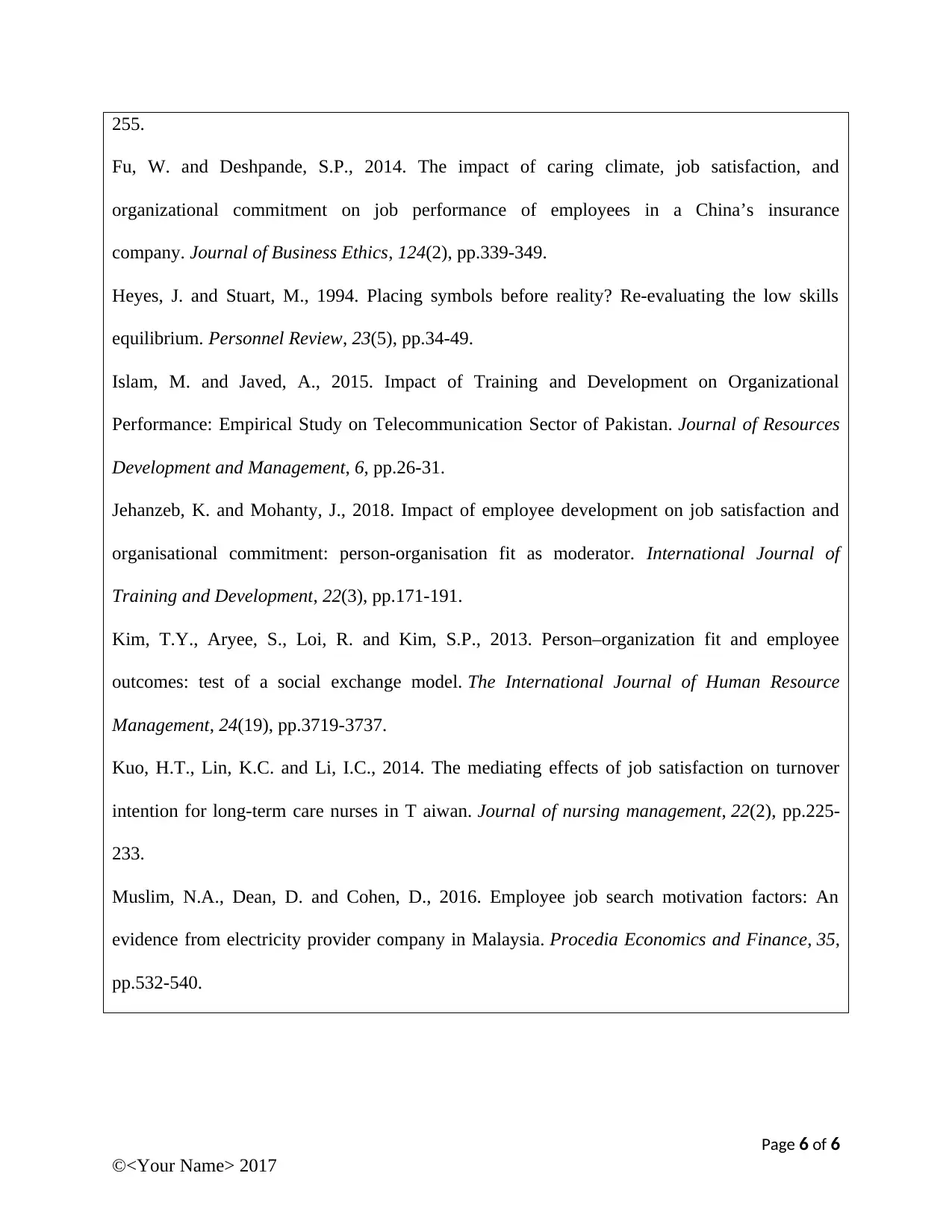Review: Employee Development, Job Satisfaction, Org Commitment
VerifiedAdded on 2023/05/27
|6
|1617
|277
Literature Review
AI Summary
This literature review examines the impact of employee development on job satisfaction and organizational commitment, drawing from the article "Impact of employee development on job satisfaction and organisational commitment: person-organisation fit as moderator." It identifies organizational commitment, job satisfaction, and employee development as key interrelated issues. The review discusses the research methods used in the study, including primary data collection through surveys and data analysis using Structural Equation Modeling (SEM) with AMOS 21.0. The study's findings suggest that employee development programs enhance organizational commitment and job satisfaction by improving employee skills and fostering a sense of empowerment. The review concludes by highlighting the contribution of the research to understanding the relationship between these elements and recommending future research to explore the impact of affective variables and feedback mechanisms on employee commitment and job satisfaction. Desklib offers a wealth of similar resources for students.

<INTERNATIONAL MANAGEMENT>
by
<Your Name>
<Date>
<Lecturer’s Name and Course Number>
Page 1 of 6
©<Your Name> 2017
by
<Your Name>
<Date>
<Lecturer’s Name and Course Number>
Page 1 of 6
©<Your Name> 2017
Paraphrase This Document
Need a fresh take? Get an instant paraphrase of this document with our AI Paraphraser

Author:
1. Khawaja Jehanzeb
2. Jagannath Mohanty
Publication year: 2018
Volume, Issue, Pages: 22, 3, 21
Title of Article:
Impact of employee development on job satisfaction and organisational commitment: person-
organisation fit as moderator
Title of Journal Publication:
International Journal of Training and Development
Identification of 3 key issues and their influences on current paper along with its research
questions:
1. This article has stressed on organisational commitment. Organisational commitment denotes
the emotional bond that has been seen between the organisation and its people. It helps in
enhancing the willingness of the corporate people to stay and perform for the organisation.
Organisational commitment denotes the loyalty of the employees for long-term. In return, the
organisational people demand security of job, promotion as well as training to improvise their
skill (Fu and Deshpande, 2014). Higher corporate commitment can enhance the efficacy of the
organisation along with its people. This denotes upgrading performance of the employees and the
organisation as well. It reduces the turnover of the employees as well.
2. Another concept stated in this article is job satisfaction. It denotes the positive attitude of the
employees towards their jobs. According to Alniaçik et al. (2013), feelings of empowerment,
proper job appraisal, justified salary, security of responsibility along with the positive
environment of the workplace are the vital factors of job satisfaction. Job satisfaction of the
Page 2 of 6
©<Your Name> 2017
1. Khawaja Jehanzeb
2. Jagannath Mohanty
Publication year: 2018
Volume, Issue, Pages: 22, 3, 21
Title of Article:
Impact of employee development on job satisfaction and organisational commitment: person-
organisation fit as moderator
Title of Journal Publication:
International Journal of Training and Development
Identification of 3 key issues and their influences on current paper along with its research
questions:
1. This article has stressed on organisational commitment. Organisational commitment denotes
the emotional bond that has been seen between the organisation and its people. It helps in
enhancing the willingness of the corporate people to stay and perform for the organisation.
Organisational commitment denotes the loyalty of the employees for long-term. In return, the
organisational people demand security of job, promotion as well as training to improvise their
skill (Fu and Deshpande, 2014). Higher corporate commitment can enhance the efficacy of the
organisation along with its people. This denotes upgrading performance of the employees and the
organisation as well. It reduces the turnover of the employees as well.
2. Another concept stated in this article is job satisfaction. It denotes the positive attitude of the
employees towards their jobs. According to Alniaçik et al. (2013), feelings of empowerment,
proper job appraisal, justified salary, security of responsibility along with the positive
environment of the workplace are the vital factors of job satisfaction. Job satisfaction of the
Page 2 of 6
©<Your Name> 2017

organisational people helps an organisation to enhance its performance by escalating its
productivity along with profitability, denoting the consumers’ satisfaction. In addition, Job
satisfaction of the employees defines the overall growth of the organisation.
3. Employee development is another concept, mentioned in the literature review of this article.
Employee development outlines the training and development program that has been provided by
the organisation to its people. It is approved as a vital element for the organisation as well as the
organisational people (Andrews et al. 2011). This type of program results in a positive outcome.
It helps the employees to bring skill development, which gradually denotes their career
development. This imposes impacts on an organisation positively, as the employees can get able
to upgrade their performance. This instantly succours a business organisation to achieve its
vision and mission in a typical timeframe. Moreover, the organisations can have a smooth and
peaceful environment in the organisation as the employees can be able to mitigate all kinds of
hindrances with the help of their developed skills.
Discussion of the methods of data collection and data analysis:
The authors have opted for primary data collection and for that, the research conductors have
conducted a session of the survey. All the respondents have been provided with 207
questionnaires. In order to analyse the stockpiled data, the conductors of the research have
chosen the technique of SEM or Structural Equation Modeling. In addition, AMOS 21.0 has
been utilised as well with the SEM techniques for testing the hypothesis of the research study.
The research conductors have done only quantitative data collection. On the other hand, the
research conductors also have gathered secondary data by utilising numerous secondary
resources.
Participants of the research:
Page 3 of 6
©<Your Name> 2017
productivity along with profitability, denoting the consumers’ satisfaction. In addition, Job
satisfaction of the employees defines the overall growth of the organisation.
3. Employee development is another concept, mentioned in the literature review of this article.
Employee development outlines the training and development program that has been provided by
the organisation to its people. It is approved as a vital element for the organisation as well as the
organisational people (Andrews et al. 2011). This type of program results in a positive outcome.
It helps the employees to bring skill development, which gradually denotes their career
development. This imposes impacts on an organisation positively, as the employees can get able
to upgrade their performance. This instantly succours a business organisation to achieve its
vision and mission in a typical timeframe. Moreover, the organisations can have a smooth and
peaceful environment in the organisation as the employees can be able to mitigate all kinds of
hindrances with the help of their developed skills.
Discussion of the methods of data collection and data analysis:
The authors have opted for primary data collection and for that, the research conductors have
conducted a session of the survey. All the respondents have been provided with 207
questionnaires. In order to analyse the stockpiled data, the conductors of the research have
chosen the technique of SEM or Structural Equation Modeling. In addition, AMOS 21.0 has
been utilised as well with the SEM techniques for testing the hypothesis of the research study.
The research conductors have done only quantitative data collection. On the other hand, the
research conductors also have gathered secondary data by utilising numerous secondary
resources.
Participants of the research:
Page 3 of 6
©<Your Name> 2017
⊘ This is a preview!⊘
Do you want full access?
Subscribe today to unlock all pages.

Trusted by 1+ million students worldwide

The research conductors have conducted survey session only. The respondents chosen for the
study are all employees, who have been working in the telecom branches. The research
conductor has selected the responses of 207 employees. All the employees belong to Pakistan.
All the respondents are from 3 metropolitan cities such as Karachi, Lahore, and Islamabad as
well. The research conductors have opted for 300 employees at first. Due to unavailability of
employees and data, the researchers have finally selected 207 respondents.
Description of research findings:
Development programs for employees can enhance organisational commitment and job
satisfaction as well. Training and development program can improve the skill of the employees
(Heyes and Stuart, 1994). This enhanced skill can provide them with assistance to develop their
career as well, and this career development can assist them in the future. When the employees
inherit sufficient organisational knowledge or field knowledge with the help of training and
development program, it helps in escalating job satisfaction among them. Islam and Javed
(2015), identified that if the employees satisfied with their jobs, it gradually denotes a good
relationship between the organisation and its people. Job satisfaction of the employees can
upgrade the productivity and profitability of a business organisation. Moreover, job description
also defines that the employees are provided with the feeling of empowerment. This feeling of
empowerment can assist the employees to perform for organisational growth.
Moreover, job satisfaction along with employment feeling can reduce the turnover of the
employees (Kim et al. 2013). It can also reduce the absenteeism of the employees as well. On the
other hand, organisational commitment can enhance job security, which gradually denotes the
job satisfaction. A real commitment can successfully escalate the rate of productivity and
profitability. In addition, this escalation can improve the overall growth of a business
Page 4 of 6
©<Your Name> 2017
study are all employees, who have been working in the telecom branches. The research
conductor has selected the responses of 207 employees. All the employees belong to Pakistan.
All the respondents are from 3 metropolitan cities such as Karachi, Lahore, and Islamabad as
well. The research conductors have opted for 300 employees at first. Due to unavailability of
employees and data, the researchers have finally selected 207 respondents.
Description of research findings:
Development programs for employees can enhance organisational commitment and job
satisfaction as well. Training and development program can improve the skill of the employees
(Heyes and Stuart, 1994). This enhanced skill can provide them with assistance to develop their
career as well, and this career development can assist them in the future. When the employees
inherit sufficient organisational knowledge or field knowledge with the help of training and
development program, it helps in escalating job satisfaction among them. Islam and Javed
(2015), identified that if the employees satisfied with their jobs, it gradually denotes a good
relationship between the organisation and its people. Job satisfaction of the employees can
upgrade the productivity and profitability of a business organisation. Moreover, job description
also defines that the employees are provided with the feeling of empowerment. This feeling of
empowerment can assist the employees to perform for organisational growth.
Moreover, job satisfaction along with employment feeling can reduce the turnover of the
employees (Kim et al. 2013). It can also reduce the absenteeism of the employees as well. On the
other hand, organisational commitment can enhance job security, which gradually denotes the
job satisfaction. A real commitment can successfully escalate the rate of productivity and
profitability. In addition, this escalation can improve the overall growth of a business
Page 4 of 6
©<Your Name> 2017
Paraphrase This Document
Need a fresh take? Get an instant paraphrase of this document with our AI Paraphraser

organisation.
The contribution of the research study to new knowledge:
These three elements such as organisational commitment, job satisfaction, and employee
development are interrelated with each other and can bring improvisation to a business
organisation. Development programs for employees can bring job satisfaction among the
organisational people (Kuo et al. 2014). When the employees are satisfied with their jobs, they
can be able to inherit the feeling of empowerment. Moreover, this kind of attitude can help the
employees to improvise their creativity. This can also assist in bringing innovation into the
organisation. In addition, real organisational commitment can improve job satisfaction. This can
point the overall growth of the organisation out in a short period (Muslim et al. 2016).
Recommendations for future research:
This research paper is very elaborative, and it provides constructive and ample knowledge about
the topic. Therefore, it would assist in the future investigations immensely. The studies that are
to get conducted in the future can stress on identifying what kind of impacts have been imposed
by the affective variables like employee empowerment, stress, the mood on the emerging
economy of a business organisation. The future researches also can spot their lights on how the
feedback along with the co-worker support can influence the commitment of the employee along
with their job satisfaction.
Reference:
Alniaçik, E., Alniaçik, Ü., Erat, S. and Akçin, K., 2013. Does person-organization fit moderate
the effects of affective commitment and job satisfaction on turnover intentions?. Procedia-Social
and Behavioral Sciences, 99, pp.274-281.
Andrews, R., Boyne, G. and Walker, R.M., 2011. The impact of management on administrative
and survey measures of organizational performance. Public Management Review, 13(2), pp.227-
Page 5 of 6
©<Your Name> 2017
The contribution of the research study to new knowledge:
These three elements such as organisational commitment, job satisfaction, and employee
development are interrelated with each other and can bring improvisation to a business
organisation. Development programs for employees can bring job satisfaction among the
organisational people (Kuo et al. 2014). When the employees are satisfied with their jobs, they
can be able to inherit the feeling of empowerment. Moreover, this kind of attitude can help the
employees to improvise their creativity. This can also assist in bringing innovation into the
organisation. In addition, real organisational commitment can improve job satisfaction. This can
point the overall growth of the organisation out in a short period (Muslim et al. 2016).
Recommendations for future research:
This research paper is very elaborative, and it provides constructive and ample knowledge about
the topic. Therefore, it would assist in the future investigations immensely. The studies that are
to get conducted in the future can stress on identifying what kind of impacts have been imposed
by the affective variables like employee empowerment, stress, the mood on the emerging
economy of a business organisation. The future researches also can spot their lights on how the
feedback along with the co-worker support can influence the commitment of the employee along
with their job satisfaction.
Reference:
Alniaçik, E., Alniaçik, Ü., Erat, S. and Akçin, K., 2013. Does person-organization fit moderate
the effects of affective commitment and job satisfaction on turnover intentions?. Procedia-Social
and Behavioral Sciences, 99, pp.274-281.
Andrews, R., Boyne, G. and Walker, R.M., 2011. The impact of management on administrative
and survey measures of organizational performance. Public Management Review, 13(2), pp.227-
Page 5 of 6
©<Your Name> 2017

255.
Fu, W. and Deshpande, S.P., 2014. The impact of caring climate, job satisfaction, and
organizational commitment on job performance of employees in a China’s insurance
company. Journal of Business Ethics, 124(2), pp.339-349.
Heyes, J. and Stuart, M., 1994. Placing symbols before reality? Re-evaluating the low skills
equilibrium. Personnel Review, 23(5), pp.34-49.
Islam, M. and Javed, A., 2015. Impact of Training and Development on Organizational
Performance: Empirical Study on Telecommunication Sector of Pakistan. Journal of Resources
Development and Management, 6, pp.26-31.
Jehanzeb, K. and Mohanty, J., 2018. Impact of employee development on job satisfaction and
organisational commitment: person-organisation fit as moderator. International Journal of
Training and Development, 22(3), pp.171-191.
Kim, T.Y., Aryee, S., Loi, R. and Kim, S.P., 2013. Person–organization fit and employee
outcomes: test of a social exchange model. The International Journal of Human Resource
Management, 24(19), pp.3719-3737.
Kuo, H.T., Lin, K.C. and Li, I.C., 2014. The mediating effects of job satisfaction on turnover
intention for long‐term care nurses in T aiwan. Journal of nursing management, 22(2), pp.225-
233.
Muslim, N.A., Dean, D. and Cohen, D., 2016. Employee job search motivation factors: An
evidence from electricity provider company in Malaysia. Procedia Economics and Finance, 35,
pp.532-540.
Page 6 of 6
©<Your Name> 2017
Fu, W. and Deshpande, S.P., 2014. The impact of caring climate, job satisfaction, and
organizational commitment on job performance of employees in a China’s insurance
company. Journal of Business Ethics, 124(2), pp.339-349.
Heyes, J. and Stuart, M., 1994. Placing symbols before reality? Re-evaluating the low skills
equilibrium. Personnel Review, 23(5), pp.34-49.
Islam, M. and Javed, A., 2015. Impact of Training and Development on Organizational
Performance: Empirical Study on Telecommunication Sector of Pakistan. Journal of Resources
Development and Management, 6, pp.26-31.
Jehanzeb, K. and Mohanty, J., 2018. Impact of employee development on job satisfaction and
organisational commitment: person-organisation fit as moderator. International Journal of
Training and Development, 22(3), pp.171-191.
Kim, T.Y., Aryee, S., Loi, R. and Kim, S.P., 2013. Person–organization fit and employee
outcomes: test of a social exchange model. The International Journal of Human Resource
Management, 24(19), pp.3719-3737.
Kuo, H.T., Lin, K.C. and Li, I.C., 2014. The mediating effects of job satisfaction on turnover
intention for long‐term care nurses in T aiwan. Journal of nursing management, 22(2), pp.225-
233.
Muslim, N.A., Dean, D. and Cohen, D., 2016. Employee job search motivation factors: An
evidence from electricity provider company in Malaysia. Procedia Economics and Finance, 35,
pp.532-540.
Page 6 of 6
©<Your Name> 2017
⊘ This is a preview!⊘
Do you want full access?
Subscribe today to unlock all pages.

Trusted by 1+ million students worldwide
1 out of 6
Related Documents
Your All-in-One AI-Powered Toolkit for Academic Success.
+13062052269
info@desklib.com
Available 24*7 on WhatsApp / Email
![[object Object]](/_next/static/media/star-bottom.7253800d.svg)
Unlock your academic potential
Copyright © 2020–2025 A2Z Services. All Rights Reserved. Developed and managed by ZUCOL.





